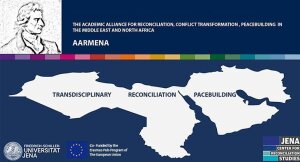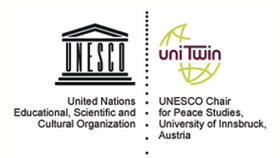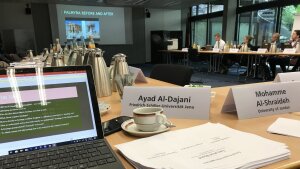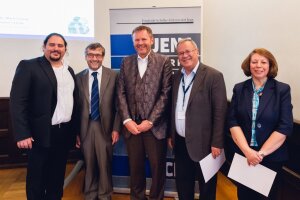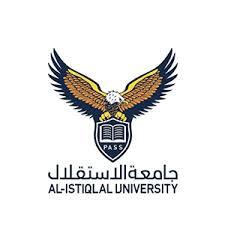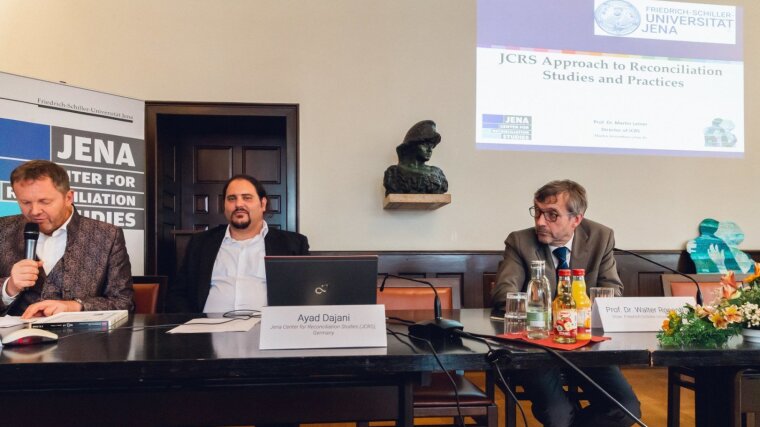
AARMENA 2-60
Image: AARMENA 2-60The Academic Alliance for Reconciliation platform - online and domestic platform
The dissemination plan will provide rich and thorough information about the project's outputs and outcomes. It involves the dissemination of information at different levels:
- Dissemination within the institutions involved in the project: Those activities will allow staff members at each participating institution to have full knowledge and understanding of the project and the results through direct communication, public presentations, informative materials, demonstrative activities.
- Dissemination in other institutions: Presentations to other staff members in institutions not taking part in the project (not part of the consortium).
- Dissemination to the Public (other stakeholders): This can be achieved through public events and presentations. For instance, at the end of the project, there will be a closing conference focused on informing the public about the project, the results, and the available resources and the way it can be accessed.
Dissemination through online environment: The website of the project will present updated information about the project, partners, activities, and results, allowing everyone to have access to information related to the project. In addition, social media (for instance a Facebook group) will facilitate the interaction with the main beneficiaries of the project.
dissemination.
The WP consists of the following tasks:
T5.1: Formation of Dissemination and Exploitation team
A dedicated internal team will be nominated to assure that activities are performed adequately and precisely. The team will be responsible for drawing up a detailed plan. The team consists of members from all participating institutions in the consortium and will be led by the WP Leader.
T5.2: Generation of dissemination and exploitation plan
The leader will form the team and will design a comprehensive dissemination and exploitation strategy / plan. The plan will be presented during the kick-off meeting. A detailed dissemination plan will address the multiplication aspects of the project results and objectives. It will be monitored, to ensure successful execution of all the activities in the dissemination WP. An exploitation plan will include recommendations for the development of research across HEIs, to be utilized and adopted by other HEIs.
T5.3: Development of project website
The website of the project will present updated information about the project, partners, activities, and results, allowing everyone to have access to information related to the project. All the intellectual outputs of this project will be available to the public during and after the project, with no limitation regarding the usage of those information or resources. The website will be updated regularly. All the dissemination activities during the project will explicitly include information about the website. All partners will take a leading role in the visibility of the website by including at least a link in their institutional websites, allowing a wider group of audiences to be accessible to the project's content (outputs and products).
T5.4: Management of project's materials and media work on the website
The project website is a necessary tool to disseminate and exploit the results of the project. In fact, the website will be utilized for two purposes. Initially, it will be used to disseminate the results of the projects (including the progress of activities, events, outputs, etc.). In addition, it will be used to share and exchange documents among the consortium partners.
T5.5: Dissemination of project activities and outcomes (radio, TV, presentations, etc.) *
T5.6: Preparation, dissemination, and publishing of brochures, handbooks, etc. *
The project involves the dissemination of information at different levels:
- Dissemination within the institutions involved in the project.
- Dissemination in other institutions.
- Dissemination to the Public (other stakeholders). The plan will utilize different materials and approaches to reach the audiences, such as:
- Dissemination through mass media
- Publications of the teaching peace and conflict transformation and reconciliation studies in the Middle East and North Africa.
- Dissemination through graphic materials:
- Dissemination through online environment:
T5.7: Preparation of final conference to stakeholders
- At the end of the project, there will be a closing conference focused on informing the public about the project, the project activities, deliverables, the results and the available resources and the way it can be accessed.
T5.8: Preparation of final dissemination, exploitation, and results report
The dissemination and exploitation team will be responsible for the preparation and submission of a comprehensive dissemination and exploitation report. The report will include a description of the project, activities, outputs, and deliverables, and dissemination materials.
T5.9: Preparation of Report
To ensure the quality of the WP and the WP deliverables, and to ensure the participation of all partners in the consortium, the WP Leader will Prepare Report. The report will include a description of the WP, the role of the WP leader, the level of involvement of all partners, the challenges faced during the implementation (for learning purposes), and a description of all deliverables.
Dissemination Committee
- Dr. phil. Iyad Muhsen AlDajani (Coordinator - University of Jena)
- Prof. Dr. Alluri, Rina Malagayo (Innsbruck University).
- Prof. Dr. Mohammad AlShrideah (University of Jordan)
- Prof. Dr.Ali Maqousi (Petra University).
- Prof. Dr. Nazmi Salhat (Al-Istiqlal University).
- Prof.Dr. Mkhaimar Abusada (Al-Azhar University).
-
a — Online platform at the University of Innsbruck
Learn moreExternal linkdeUNESCo chair for peace
Image: UNESCo chair for peaceThe research would introduce the integration for the reconciliation theory the Hölderlin perspective for the Jena Center for Reconciliation Studies (JCRS) Prof. Dr. Martin Leiner at Friedrich Schiller University within the Elicitive conflict transformation and transitional shifts towards Many Peaces for Prof. Dr Wolfgang Dietrich at the UNESCO Chair for Peace Innsbruck University. The theories would then be applied in the master program built in the AARMENA Program for the Higher Education Institutions in the Middle East and North Africa. The data derived from this research would be developed in rigged data to use machine learning and artificial intelligence applications to develop stability and validity for the AARMENA program.
Done By Dr. phil Iyad AlDajani
-
b — Online platform at the University of Jordan
Learn moreExternal linkdemeeting
Image: privateThe AARMENA is researching with the University of Jodan, a program titled applied ethics in digital humanities, that researchers applied artificial intelgence and machine leanring as best practice in digital humanities, the program is part of a master program in computer science at the university of Jordan .
Supverisor of the Project:
Prof. Dr. Mohammed AlShridah
Dr. phil. Iyad AlDajani -
c — Online platform at Petra University
AARMENA-2018
Image: AARMENA-2018AARMENA with University of Petra - AMMAN.
AARMENA with the university of petra team are working on developing a capacity building project, that will develop research on reconciliation and peace studies, including curriculum building and capacities for teaching the program as a master program at Petra University.
-
d — Online platform at Al-Itiqlal University
Learn moreExternal linkdeistiqlal uni
Image: istiqlal uniAARMENA is developing a master proram in reconciliation studies with cooperation of Al-Istiqlal University in Jericho - Palestinian territories.
-
e — Online platform at Al-Azhar University
Learn moreExternal linkdeAl-Azhar University
Image: Al-Azhar UniversityAARMENA is developing master program in reconciliation studies at the Al-Azhar University in Gaza, Paletinian Territories.
